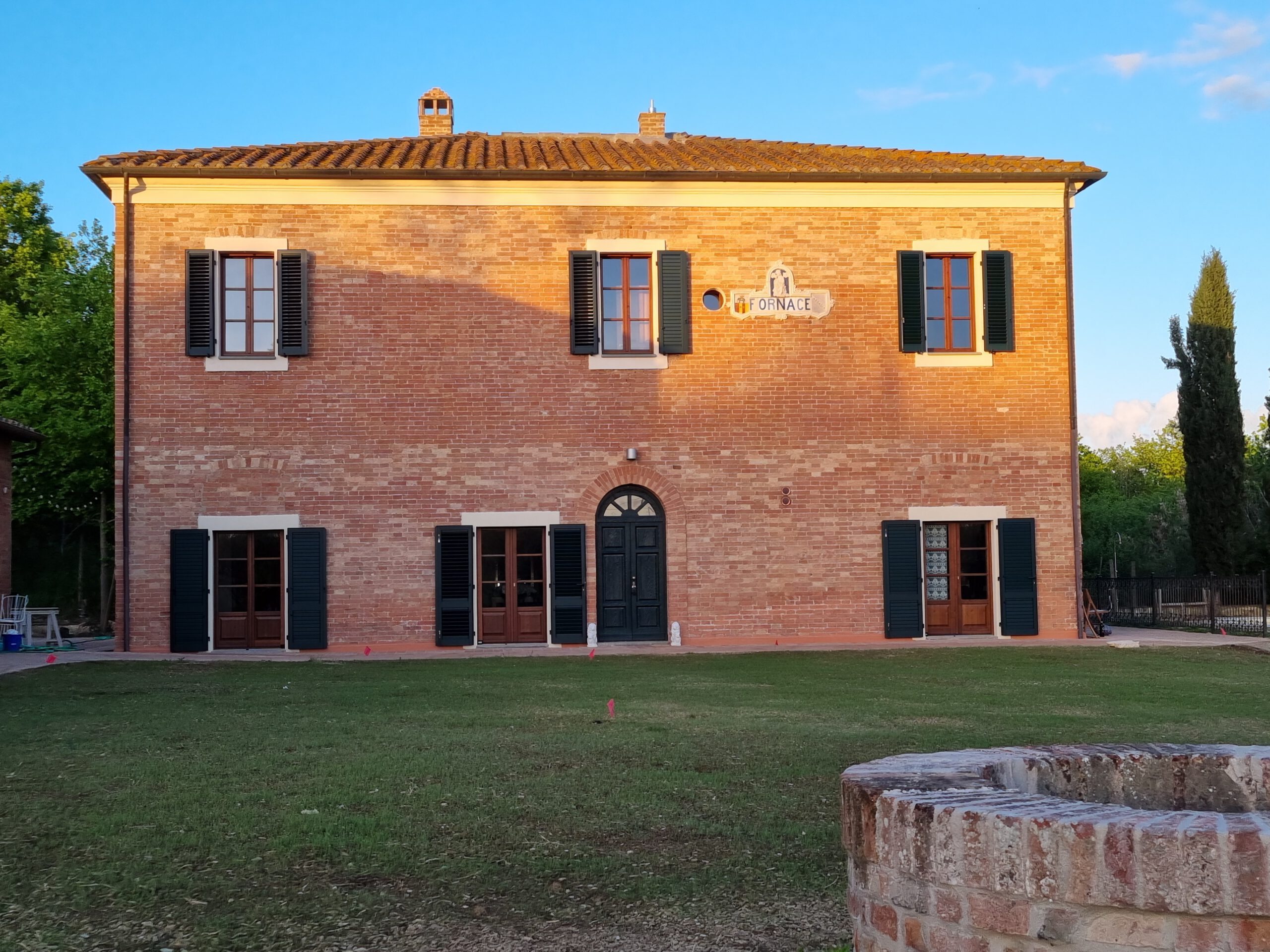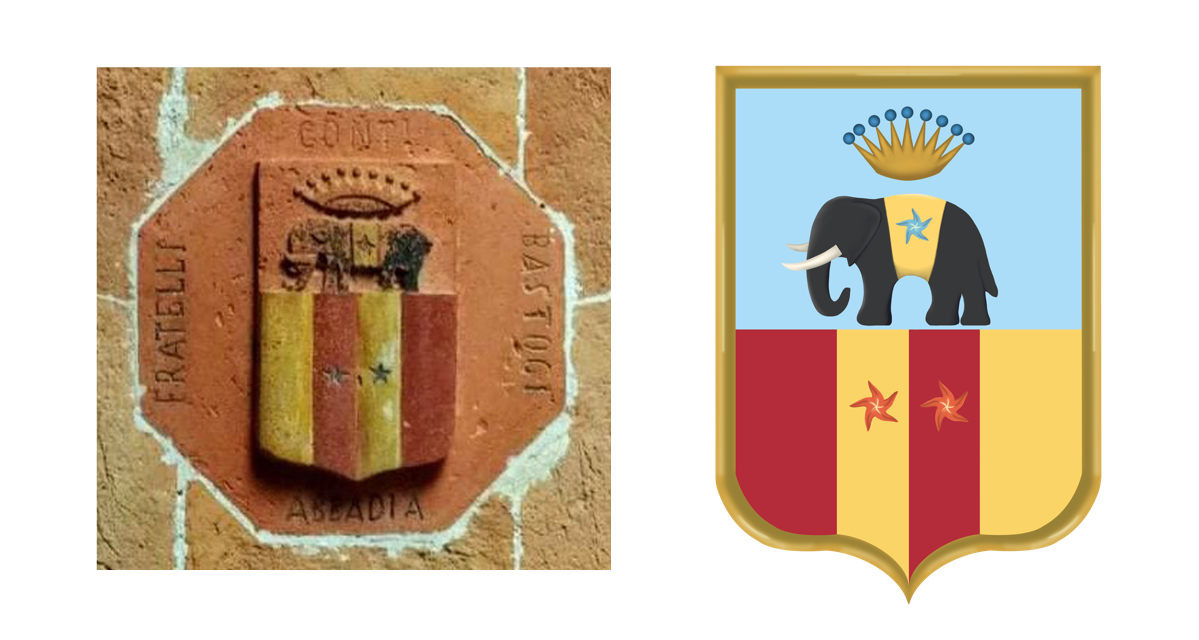Rest and Recreation
Quiet enjoyment and relaxation: This is what the “Fornace Del Conte”, the former “Count’s furnace”, means to us. We have made it the heart of our agriturismo, preserving and restoring its ancient architecture. We would like to pass on to our guests what this place has given us: joy, friends and a new perspective on our lives. – Enjoy with all your senses what our Tuscan idyll has to offer.
Rest
Let the birds and the morning sun wake you up. Listen to the wind gently blow through the grapevines and trees in the neighboring grove. Enjoy a rich breakfast with Tuscan delicacies. Admire the view over the vineyard and Montepulciano from the terrace, read a book from our library and take a refreshing dip in the pool. Or take a trip to one of the many magical towns around.
After the “Cena”, the dinner that we serve together on request in good Tuscan tradition for all guests at a long table, the sun says goodbye with an afterglow that plays with all colors from glowing orange to a shimmering violet and finally the dark sky leaves to the stars and shooting stars. The cicadas are now chirping in the cypresses.
From the “Terrazza del vigneto” you can watch the grapes for the next vintage of our wine ripening. Or you can choose one of the other, lovingly designed places that are spread over our property for a glass of our “Fornace Del Conte”: The “Rotonda d’Amore” at the well, surrounded by the scent of roses. One of the two “Terrazze di mattoni” where the bricks used to be dried before they went into the furnace and today it smells of lavender and lemon blossoms. Or the courtyard at the old fountain in the “Cortile della Fontana”. Days can’t start more beautifully, they can’t end more unforgettable.
Recreation
Our 300-year-old property is located in southern Tuscany between Siena, Lake Trasimeno and Orvieto, an area that is considered the “heart and soul of the Etruscan country”, the region of Italy that is equally popular with art and culture enthusiasts, gourmets and chefs. It‘s one of the most culturally interesting regions of Italy.
Delicacies for every time of the day: Prepared with love and ingredients from organic and sustainable agriculture, we offer you e.g. homemade bread and pasta, wine from our own vineyard and the popular “Pizza Del Conte” from our stone oven.
Culture in every season: We would like to share our love for literature, music and art with our guests. Despite all our differences, culture connects us across all borders and is, in whatever form, a message of peace and freedom. This is one of the reasons why the promotion of culture of all kinds is particularly important to us. We therefore regularly invite you to readings, concerts and exhibitions in the “Fornace Del Conte” – in our garden in summer, in our “Sala della Cupola” in spring and autumn. This is the current program.
Trips & Guided Tours
Rolling hills crowned by medieval villages surrounded by vineyards, olive groves and grain fields. Here and there streets snake through, from which cypress avenues lead to picturesque estates. We organize trips and guided tours for you off the tourist track: through landscapes and in villages with sights that have been able to keep their proverbial aura precisely because they are a few kilometers off the “main routes”.
Wine Tastings & Cooking Classes
You can appreciate good wine without knowing much about it. However, true enjoyment of wine begins the moment we understand more about it. We offer wine tastings and seminars – casually in our big historic guest hall of the “Fornace Del Conte” or at one of the wine estates in the region close-by.
Tuscan cuisine relies on appearingly simple dishes. But precisely because only a few ingredients, herbs and spices are used, the way they are prepared plays a very decisive role in addition to their quality – and is often the reason why what was a real treat on holiday doesn’t taste quite right at home. Guided by chefs from the region, you can learn with us what the secret of a real “Ribollita” is – probably the most famous dish of the Tuscan tradition, how the traditional pasta (pici) is rolled or how you make ice cream from olive oil. Create something that your guests at home will savour for a long time to come.
Seminars
We also regularly organise seminars and workshops on the ‘Fornace Del Conte’. If you would like to offer a seminar or a workshop yourself, consult us regarding the possibilities. We will convert the “Sala della Cupola” into a conference room for this purpose. If more rooms are required than we have, we cooperate with neighboring agriturismi that offer a comparable standard. Our transport service takes care of the transport between the overnight stay and the seminar location and is also available if someone needs to go to their quarters in between. Please refer to the respective announcements for costs for upcoming seminars. To calculate the costs of a seminar or workshop that you would like to hold with us, please contact us.

History in this region has not been forgotten – it lives on in every house and every alley.
From the Etruscans to today. From their advanced culture to the realisation of how much we can and should learn from this epoch in order to preserve what is given to us. Our aim as your hosts is to provide details whenever requested, but at the same time exercise restraint when our guests want to be alone.
That’s why you will always find both in our apartments and rooms: tips for tours beyond the well-known and offers for excursions that we plan individually with and for you. This way, you will experience places for which there is not enough space in the usual travel guides to mention them.
The Elephant
The coat of arms of the “Fornace Del Conte” is divided into two superimposed halfs. In the lower, slightly larger half, four upright bars are lined up next to each other. Halfway up the stripes are stars whose round, soft shape is reminiscent of stylised flowers.
Even the colouring of the coat of arms is unusual. It is true that red can be found in many coats of arms and flags in Tuscany. However, the combination of yellow and red does not appear in any other traditional coat of arms of any of the major Tuscan cities or any of the leading aristocratic families in the region. For patriotic reasons or as a sign of hierarchical expression of respect, a count usually referred to one of these two specifications when choosing “his” coat of arms colours; often he even had to.

The Count of the “Fornace Del Conte”, however, does not seem to have found such a sign of subordination necessary. Our “Conte della Fornace” was obviously self-confident enough to choose his own colors: yellow and red. In addition, as a background in the upper field, a light blue. Yellow and red, chosen for a brick factory: the thought of wood and fire, clay and brick is not too far off. The stars could stand for two children who were born to the count’s couple. Then above all, as a background in the upper field of coat of arms, the blue of the sky.
The icon in this upper field makes the coat of arms an exceptional historical testimony of the region. At the top is a nine-pointed crown. In the coat of arms symbolism of the Italian nobility, such a crown belongs to a count or a family of counts. So far, so understandable. The coat of arms of the “Fornace Del Conte” became the subject of legends and speculation because of the animal over which this crown hovers: an elephant.
Depicted somewhat awkwardly in proportions by the painter of the coat of arms, the pachyderm stands with a hanging trunk, i.e. in a relaxed posture, and looks towards the left side of the coat of arms. That, too, should not be without significance. Unless two heraldic animals – for example lions, horses, peacocks or doves – face each other or the double-headed eagle, which is also popular with the Italian nobility, looks in two directions – the gaze of a heraldic animal in Italian coats of arms is usually to the right. To where heraldry located the center of every rule, in this case: the capital of the Roman Empire or the seat of the regional rulers in Siena or Florence, depending on the time the coat of arms was created.
Our Conte, on the other hand, didn’t seem to care much about this tradition. He decided to show the rulers a certain amount of disrespect – represented by the elephant looking to the left instead of to the right, i.e. turned away from those who were higher in the hierarchy. It wasn’t subtle.
The elephant on a wall of yellow and blue stripes and protected by the count’s nine-pointed crown adorns both the front of the main house of the “Fornace Del Conte” and the keystone in the vaulted ceiling above one of the two on the ground floor and on either side of the main entrance lying administration rooms. “To the right of the main entrance” may also have been of hierarchical importance in this context. This room was probably the office of the head of the count’s brickworks, or even the office of the count himself, provided that he was involved in the business of his brickworks.
Since the restoration of the “Fornace Del Conte” in 2021/2022, one of the two guest apartments has been created here. But why an elephant? And: where did he look? How does an elephant get into a count’s coat of arms in Tuscany? And what’s more: in the coat of arms that this count has created for his brick factory?
The most coherent explanation leads to an event that took place more than two millennia ago not far from Abbadia di Montepulciano and whose impact of historical dimensions not only for the region and the Holy Roman Empire, but for the development of the entire European continent on both sides of the Alps was: The Battle of Lake Trasimeno, in which Hannibal, the commander of the army from Carthage in present-day Tunisia, inflicted a crushing defeat on the Roman Empire in 217 BC and brought it to the brink of collapse.
Lake Trasimeno is just a few kilometers from Abbadia di Montepulciano. From the point of view of an army commander who had just come with 50,000 soldiers, 9000 horsemen and 37 elephants from the Iberian Peninsula across the Alps to the area between Arezzo and Montepulciano it seems very close; but at the same time: at a safe distance.
It is known with certainty that Hannibal camped in this area with his army and prepared for battle against the approaching Romans.
Of the original nearly 60,000 soldiers and 9,000 horses, about a quarter had been lost crossing the Alps and intervening battles, and a few thousand more had been left behind to secure the conquered areas along the route. Of the 37 elephants, only one managed the arduous journey – his own. According to legend, Hannibal never let him out of his sight, always took him into his tent at night and had assigned soldiers to guard him while he slept.
However, the commander could not take his elephant with him to the battle of Lake Trasimeno. For the battle against the Romans, Hannibal had devised a plan whereby he would hide with his fighters on the eastern hills above the lake and surprise the Romans as soon as they arrived on the northern lakeside below the hills. He could not take his beloved elephant there with him. He left him in the place closest to the battlefield, but at the same time safe and provided with sufficient water and plants.
There are many indications that this must have been at the site of today’s “Fornace Del Conte”. So our Conte seems to have been quite an educated and history-conscious man, which certainly could not be said of everyone of his class. Above all, however, he was probably anything but a friend of the Roman Empire and probably not one of the kind who blindly submit themselves hierarchically. Rather – as every single symbol in his coat of arms indicates – lived in him a fairly independent, also idiosyncratic head – and a rebel.
